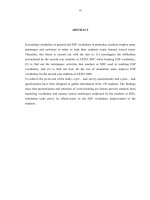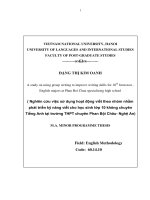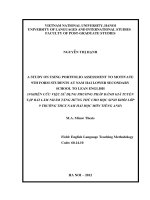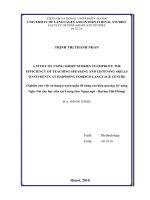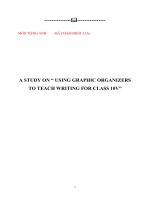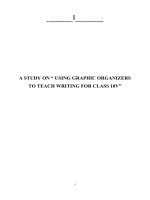A study on using visual aids to teach ESP vocabulary for the students of the Shipbuilding Faculty at the Central Vocational College of Transport NoII sử dụng
Bạn đang xem bản rút gọn của tài liệu. Xem và tải ngay bản đầy đủ của tài liệu tại đây (679.48 KB, 53 trang )
VIETNAM NATIONAL UNIVERSITY, HANOI
UNIVERSITY OF LANGUAGES AND INTERNATIONAL STUDIES
FACULTY OF POST-GRADUATE STUDIES
BUI THI PHUONG THAO
A STUDY ON USING VISUAL AIDS TO TEACH ESP VOCABULARY
FOR THE STUDENTS OF THE SHIPBUILDING FACULTY AT THE
CENTRAL VOCATIONAL COLLEGE OF TRANSPORT NO. II
(NGHIÊN CỨU VỀ VIỆC SỬ DỤNG GIÁO CỤ TRỰC QUAN ĐỂ DẠY
TỪ VỰNG TIẾNG ANH CHUYÊN NGÀNH CHO SINH VIÊN KHOA
ĐÓNG TÀU TRƯỜNG CAO ĐẲNG NGHỀ GIAO THÔNG VẬN TẢI
TRUNG ƯƠNG II)
M.A. MINOR THESIS
Field: English Teaching
Methodology
Code: 60.14.10
HANOI - 2012
VIETNAM NATIONAL UNIVERSITY, HANOI
UNIVERSITY OF LANGUAGES AND INTERNATIONAL STUDIES
FACULTY OF POST-GRADUATE STUDIES
BÙI THỊ PHƯƠNG THẢO
A STUDY ON USING VISUAL AIDS TO TEACH ESP
VOCABULARY FOR THE STUDENTS OF THE SHIPBUILDING
FACULTY AT THE CENTRAL VOCATIONAL COLLEGE OF
TRANSPORT NO. II
(NGHIÊN CỨU VỀ VIỆC SỬ DỤNG GIÁO CỤ TRỰC QUAN ĐỂ DẠY
TỪ VỰNG TIẾNG ANH CHUYÊN NGÀNH CHO SINH VIÊN KHOA
ĐÓNG TÀU TRƯỜNG CAO ĐẲNG NGHỀ GIAO THÔNG VẬN TẢI
TRUNG ƯƠNG II)
M.A. MINOR THESIS
Field: English Teaching Methodology
Code: 60.14.10.
Supervisor: VŨ THỊ THU THỦY, M.A.
HANOI - 2012
iv
TABLE OF CONTENTS
Contents
Page
number
Declaration……………………………………………………….
i
Acknowledgement……………………………………………….
ii
Abstract ………………………………………………………….
iii
Table of contents………………………………………………
iv
List of abbreviations…………….……………………….……
viii
PART 1: INTRODUCTION………………………………
1
1. Rationale of the study……………………………………….
1
2. Research questions and aims of the study………………….
2
3. Scope of the study…………………………………………
2
4. Significance of the study…………………………………….
2
5. Methods of the study…………………………………
3
6. Design of the study………………………………………….
3
PART 2: DEVELOPMENT………………………………………
5
CHAPTER 2: LITERATURE REVIEW…………………………
1.1. An overview of ESP………………………………………
5
1.1.1. The definitions of ESP………………………………
5
1.1.2. Classification of ESP………………………………….
6
1.2. Vocabulary in ESP teaching……………………………….
7
1.2.1. Definition of vocabulary……………………………
7
1.2.2. Classification of vocabulary and ESP vocabulary….… 8
v
1.2.3. The issue of teaching ESP vocabulary………………
9
1.2.3.1. Selection of vocabulary for teaching……………
9
1.2.3.2. Stages in teaching vocabulary……………………
10
1.2.3.2.1. Presenting……………………………………
10
1.2.3.2.2. Practicing…………………………………….
11
1.2.3.2 .3. Revising……………………………………
12
1.3. Visual aids in teaching and learning vocabulary…………
12
1.3.1. Boards………………………………………………
12
1.3.2. Overhead-projectors…………………………………
13
1.3.3. Pictures………………………………………………
13
1.3.4. Objects………………………………………………
14
1.3.5. Gestures, mine, actions and performance……………
14
1.4. Benefits of using visual aids to teach ESP vocabulary…… 15
CHAPTER 2: METHODOLOGY………………………………
16
2.1. Situation analysis…………………………………………
16
2.1.1. Learning situation……………………………………
16
2.1.2. Textbook……………………………………………
16
2.1.3. Students……………………………………………….
17
2.2. Research methodology……………………………………
17
2.2.1. Research questions……………………………………
17
2.2.2. The participants……………………………………….
18
2.2.3. The instruments……………………………………….
18
2.2.3.1. Instrument A – Survey questionnaires……………
18
2.2.3.2. Instrument B – Class observation………………
19
vi
CHAPTER 3: DATA PRESENTATION AND DICUSSION OF MAJOR
FINDINDS……………………………………………………… 20
3.1. Data presentation…………………………………………
20
3.1.1. Data from the survey questionnaires………………….
20
3.1.1.1. The teachers’ and the students’ attitudes towards the
use of visual aids in teaching and learning vocabulary…………
20
3.1.1.2. The teachers’ and the students’ opinion on purposes
of teaching and learning vocabulary in shipbuilding……………
21
3.1.1.3. Frequency of visual aids used in teaching
vocabulary and students’ impression of visual aids………………
22
3.1.1.4. The stages at which visual aids are often used and
the students’ response…………………………………… ………
25
3.1.1.5. Benefits of using visual aids to teach and learn
vocabulary in shipbuilding………………………………… ……
26
3.1.1.6. The teachers’ and students’ difficulties in teaching
and learning vocabulary in shipbuilding through visual aids…….
28
3. 1.1.7. The suggestions made by the teachers for using
visual aids to teach vocabulary in shipbuilding………………….
31
3.1.2. Data from the classroom observation…………………
32
3.2. Discussion of major findings……………………………
34
3. 2.1. The situation of current teaching and learning ESP
vocabulary…………………………………………………………
34
3.2.2. The kind of visual aids to teach ESP vocabulary…….
34
vii
3.2.3. The frequency of using visual aids to teach ESP
vocabulary…………………………………………………………
35
3.2.4. The stages at which visual aids are used most often in
ESP vocabulary lessons………………………………………….
35
3.2.5. The difficulties in using visual aids to teach ESP
vocabulary……………………………………………………….
35
PART 3: CONCLUSION………………………………………
36
1. Implications………………………………………………….
36
2. Conclusions………………………………………………….
37
3. Limitations of the study………………………………
37
4. Suggestions for further study…………………………
38
REFERENCES………………………………………………….
39
APPENDICES
viii
LIST OF ABBREVIATIONS
GE: General English
ESP: English for Specific Purposes
EST: English for Science and Technology
EBE: English for Business and Economics
ESS: English for Social Studies
EAP: English for Academic Purposes
EOP: English for Occupational Purposes
M.A: Master of Arts
CVCOT: Central Vocational College of Transport No. II
1
PART 1: INTRODUCTION
1. Rationale of the study
Vocabulary teaching is one of the most important components of any
language class. The main reason is the fact that it is a medium, which carries
meaning; learning to understand and express the meaning is what counts in
learning languages. There has been increased focus on teaching vocabulary
recently, “If language structures make up the skeleton of language, then it is
vocabulary that provides the vital organs and the flesh” (Harmer 1993:153).
Vocabulary functions as a cornerstone without which any language could not
exist. Speaking would be meaningless and perhaps impossible having only
structure without vocabulary. A good mastery of vocabulary is essential for
learners, especially for those who learn for specific purposes. The main
objective of English for specific purposes has always been the teaching of
highly specialized vocabulary to specialists in various domains.
I myself have experienced 10 years of working as a teacher of English at the
Central Vocational College of Transport No.II where students will be future
technicians and workers. Most of the students here find learning ESP
vocabulary the most challenging to them in acquiring English. Our students’
biggest obstacle in learning ESP vocabulary is that it is difficult for them to
identify the meaning of, to understand the use of and to remember the words
belonging to technical terms. In fact, the students’ problems always haunt the
teachers, which urge them to find a suitable solution to ESP vocabulary
teaching and learning at the college to satisfy the students’ need.
The idea of using visual aids in teaching vocabulary is a good one. This can
add colors to an English lesson and motivate students to learn vocabulary,
2
especially ESP vocabulary. There is no reason for them to feel that learning
vocabulary is dull. At my college, visual aids have been used to teach ESP
vocabulary. So I conduct this study to get an insight of the current situation of
using visual aids to teach ESP vocabulary at the Central Vocational College
of Transport No.II. It is hoped that this study will be of some values to my
colleagues and those who want to improve their ESP vocabulary teaching.
2. Aims of the study
To clarify the answer to the research question, the study aims at:
● Investigating the current situation of using visual aids to teach ESP
vocabulary at the Central Vocational College of Transport No.II.
● Exploring the difficulties facing teachers and students in teaching and
learning ESP vocabulary through visual aids.
● Providing some solutions to those difficulties to help teaching ESP
vocabulary through visual aids more effectively.
3. Scope of the study
Due to the time constraints and the scope of the study, the study only
concentrates on how visual aids are used to teach ESP vocabulary to the
students of the Shipbuilding Faculty at CVCOT.
4. Significance of the study
The study is significant for the following reasons: firstly, it studies current
situation of using visual aids at CVCOT. Secondly it finds out difficulties in
using visual aids to teach ESP vocabulary. Thirdly, it suggests
recommendations to teach ESP vocabulary more effectively. So it is useful for
both teachers and students of English. In addition, it would become a good
3
source of reference to those who are concerned with vocabulary teaching and
learning.
5. Methods of the study
The method of this study is survey study because it was conducted by using
questionnaires and classroom observation to collect data. The data for the
study came from two sources: teacher respondents and student respondents at
the Central Vocational College of Transport No.II. Classroom observation
was carried out to supplement the survey questionnaires, which is hoped to
bring more reliable results for the study.
6. Design of the study
The study consists of five chapters:
Chapter 1 is “Introduction”, which deals with the background, the rationale,
the aims, the scope, the methods, the significance and the design of the study.
Chapter 2, “Literature Review” presents a brief view on ESP, the theoretical
background of vocabulary and ESP vocabulary, the overall view of some
visual aids.
Chapter 3, “Methodology” mentions the setting of the study, the participants,
the instruments, the data collection procedure, the data analysis procedure and
a brief summary.
Chapter 4, “Data presentation and discussion” presents the data collected
from the survey questionnaires and class observation as well as the discussion
of the data.
Chapter 5, “Implication and Conclusion” presents the pedagogical
implications in teaching ESP vocabulary through visual aids and the
4
conclusion of the study. Suggestion for further study is also given. Finally, the
appendix presents the survey questionnaires.
5
PART 2: DEVELOPMENT
CHAPTER 1: LITERATURE REVIEW
This chapter surveys the literature on some basic concepts related to ESP,
vocabulary, ESP vocabulary and visual aids. Besides, the issue of teaching
vocabulary and the benefits of using visual aids to teach vocabulary are
presented to provide a theoretical background for the study.
1.1 An overview of ESP
1.1.1 The Definitions of ESP
The study of English for specific purposes (ESP) has had a long and
interesting history. ESP became a vital and innovative activity within the
teaching of English in the 1970s. It really has had a relatively long time to
mature. So there are a great number of definitions for ESP.
A definition of ESP was offered by Hutchinson and Waters (1987:19) “ESP
is an approach to language teaching in which all decisions as to content and
methods are based on the learners’ reason for learning”. They mean that ESP
does not involve a particular kind of language, teaching material or
methodology. For them, the foundation of ESP involves the learners, the
language required and the learning context which are based on the primary
need in ESP.
According to P. Strevens (1988) ESP consists of English teaching which is
● designed to meet specified needs of the learner;
● related to content (i.e. in its themes and topics) to particular disciplines,
occupation and activities;
6
● center on the language appropriate to those activities in syntax, lexis,
discourse, semantics, etc;
● in contrast with General English
Dudley- Evans and St John share the same ideas and expose their revised
view on the essence of ESP from two perspectives: absolute characteristics
and variable characteristics. The division of ESP into absolute and variable
characteristics, in particular, is very helpful in resolving arguments about
what is and is not ESP.
To sum up, the definitions above show that ESP is an approach to language
teaching which is directed by specific and apparent reasons for learning. It is
not concerned with an exact discipline and we can teach ESP to learners at
any age and at any English level.
1.1.2. Classification of ESP
The teaching of English is divided into several branches. Dudley Evans and
St John (1998:54) divide ESP into English for Academic Purposes (EAP) and
English for Occupational Purposes (EOP). EAP stands for English for
Academic Purposes in which English for Science and Technology has been
the main area. EOP (English for Occupational Purposes) includes professional
purposes in administration, medicine, law and business, and vocational
purposes for non-professionals in work or pre-work situations.
Dudley Evans and St John (1998: 6) devise a tree diagram illustrated in
figure 1 below for ESP which divides EAP and EOP according to discipline
or professional area.
7
English for specific Purposes
English for Academic Purposes
English for Occupational Purposes
English for
(Academic)
Science and
Technology
English for
(Academic)
Medical
purposes
English for
(Academic)
Legal
purposes
English for
Management.
Finance and
Economics
English for
Professional Purposes
English for Vocational
Purposes
English for
Medical
Purposes
English for
Business
Purposes
Pre -
Vocational
Purposes
Vocational
English
Figure 1: ESP classification by professional area
Meanwhile, Robinson family’s tree of ESP (1991) divides it into EAP and
EOP, a useful division of courses according to when they take place. In
addition, David Carter (1983) classifies ESP into three types:
● English as a restricted language
● English for Academic and Occupational Purposes
● English with specific topics
Furthermore, Hutchinson and Waters (1987:21) divide ESP into English for
Specific Purposes and General English which have three main branches:
English for Science and Technology (EST), English for Business and
Economics (EBE) and English for Social Studies (ESS).
Although there are differences concerning the types of ESP among Dudley
Evans & John, Robinson, David Carter and Hutchinson & Waters, the two
categories of EAP and EOP in ESP are widely accepted nowadays in ESP
teaching area.
1.2. Vocabulary in ESP teaching
1.2.1. Definition of vocabulary
8
There have been different definitions of vocabulary by linguists depending on
the criteria that they consider the most important in terms of linguistics,
semantics, lexicology, etc. Richards and Platt (1992: 400) define that
vocabulary is “a set of lexemes including words, compound words and
idioms”. This statement indicates that vocabulary is “the total number of
words in a language” (Hornby, 1995: 1331). We can conclude that vocabulary
is a single word or a group of words from two or more words expressing an
idea to multi-word idioms which can be only understood in the sentence or in
the context.
1.2.2. Classification of vocabulary and ESP vocabulary
Vocabulary can be classified in different ways based on different criteria,
features or functions.
Semantically, it can be divided into notional words which are objects, actions,
qualities, etc. and functional words which are those whose meanings are
grammatical. Grammatically, vocabulary can be divided into different parts of
speech: nouns, verbs, adjectives, adverbs, prepositions, etc. Methodologically,
there are two kinds of vocabulary classification. They are active vocabulary
and passive vocabulary. Active words consist of words which the learners can
understand and pronounce the words correctly and use them constructively in
speaking or writing. Passive vocabulary includes words which the learners
can recognize and understand while they are reading or listening to someone
speaking, but they do not use the words in speaking or writing.
Recently, some methodologists of the Communicative Language Teaching
approach have split vocabulary into productive and receptive vocabulary. The
productive vocabulary is concerned with the words that a learner can use
effectively to express his/ her ideas both in speaking and in writing forms.
9
The receptive vocabulary refers to the words that help a learner to receive and
understand information in listening and reading.
There are different types of ESP vocabulary presented by Simon Fraser
(2005).They are general vocabulary, academic vocabulary and technical
vocabulary. General vocabulary consists of words remaining after technical
and academic words have been extracted. Most of these will be high
frequency words that are used in daily life as well as in a specific field.
Academic vocabulary consists of words used which are common in the
academic world, irrespective of the subject. Technical vocabulary is most
obviously associated with specialized texts or discourse. These words have
their specific meanings and they seem to be very uncommon to people who
are not related to their fields of meaning. It can be further divided in to fully
technical vocabulary, crypto technical vocabulary, lay- technical vocabulary.
Fully technical vocabulary comprises those words whose meanings are clearly
technical. They are specific to the field and not likely to be known in general
language. Crypto technical vocabulary consists of polysemous words like
transmitter and relaxation which could be said to be “cryptic” in that they
have a hidden technical meaning. Lay technical vocabulary comprises those
terms which are obviously technical but are likely to be known by a layperson.
Dudley Evans and St John (1998) are of the opinion that teaching ESP
vocabulary is the same as teaching English for general purposes. The only
distinction that should be made is between the vocabulary for comprehension
and the vocabulary for production.
1.2.3. The issue of teaching ESP vocabulary
1.2.3.1. Selection of vocabulary for teaching
10
The initial step that ESP teachers have to do is making decision on which
words to teach. Gairns and Redman (2003) emphasize the principles of need
and level. Authors of teaching material and teachers should also take into
account the criteria of learnability and teachability. Harmer (1991:154-156)
confirms that “one of the most common principles of vocabulary selection is
to teach at first concrete words and gradually abstract words”. Concrete words
are easily presented and explained because students can see and imagine the
real thing which the words present. On the contrary, abstract words are more
difficult to explain. There are also words that concerned each other in theme.
Words that have this kind of word thematic relationship are said to belong to
the same lexical field. After selecting words to teach, it is essential for
teachers to determine what to teach about each naming unit. According to
Thornbury (2002:15), knowledge of a word involves knowing its meaning
(meanings in context, sense of relation “synonyms/antonyms”), its form
(spelling and pronunciation affixes, parts of speech), grammar (plural,
countability, past simple/participle form) and its usage (collocations and
appropriate register).
1.2.3.2. Stages in teaching vocabulary
There are three stages in teaching vocabulary namely presenting, practicing
and revising.
1.2.3.2.1. Presenting
The main aim of presenting vocabulary is to introduce the meaning, the form
and appropriate usage. There are quite a lot of methods and techniques to
present the form and meaning of vocabulary. It depends on teachers who
decide which form of presentation is the most suitable for a particular topic.
11
According to Gairns and Redman (2003:73), a variety of ways can be used in
introducing vocabulary such as:
● Visual technique: visuals, demonstrating.
● Verbal technique: illustrative situations (oral or written), synonyms and
antonyms, definitions and explanations, scales, example of the type,
translation, guessing from the context (matching / labeling).
1.2.3.2.2. Practicing
Students often need a little time for the new lexical items to “sink in”. Gower,
Phillips and Waters (2005) pointed out that learners may recognize new item
but often delay putting it into active use. In this case, the use of planned
activities for recycling and reactivating the new vocabulary is necessary.
Thornbury (2002:93) states that “practice makes perfect”. There are many
practice activities that include repeating of the new vocabulary to fix the new
words in the learners’ memory. The practice activities are divided into two
main groups: receptive and productive. In receptive practice, the learners do
not really produce the target words. Receptive practice includes four
activities: identifying, selecting, matching, sorting, ranking and sequencing.
In productive practice, the productive skills (writing or speaking) are
incorporated in the vocabulary teaching. Receptive practice includes two
types: completion and creation or controlled practice and free practice.
Controlled practice has to come first because controlled activities require the
students to produce a certain structure. The second phase, which demands
productive use of vocabulary, is free practice. Free practice is aimed at
fluency and is productive. However, Gairns and Redman warn against “a
certain degree of stress involved in productive practice”. According to them,
practice should be challenging, but not frustrating or stressful for the learners.
12
All above, practice promotes fluency and improves pronunciation, it helps the
memory to store words, and retrieve them later. It can not be denied that
conversations in English are very motivating and help build learners’
confidence so learners can expect to get the opportunity to practise new
language.
1.2.3.2.3. Revising
In accordance with presenting and putting words into practice, checking
students’ comprehension and revising those words are a final important stage
in teaching this specific field. Thornbury (2002:100) states that the third stage
sounds familiar and may be equated to the second one, however; as its name
suggests, in this stage, students are advised to complete high-level tasks
namely production tasks. So, production tasks are one of the most important
tasks in this stage.
1.3. Visual aids in teaching and learning vocabulary
Visual aids are defined by Dictionary of English and Culture (1998: 1490) as
“something that people can look at to help them understand, learn, remember,
etc. such as a picture, a map, a photograph, or a film. Visual aids are often
used as materials in education”. Here are some typical types of visual aids.
1.3.1. Boards
Boards are found in most classrooms. They are chalk boards and white boards.
● Chalk boards are usually black or green. They are easy, cheap to use and
very adaptable. Some chalks boards are magnetized allowing pictures, word
cards, etc. to adhere to the surface if magnets are placed on top of them.
● White boards are rather common nowadays. They are more expensive than
chalk boards. Special pens must be used. White boards are easier to keep
13
clean and to stick pictures and cards to their surface with sticky or adhesive
plastic than chalk boards.
It is obvious that boards are common and very important. They can serve
different purposes. As they can be used to present vocabulary, spelling, giving
a model. More importantly, teachers can draw on the board to present new
words. Also, by that way they can create visual aids and make their lessons
much more interesting.
1.3.2. Overhead projectors
Nowadays, overhead projectors are always in the hands of language teachers
because they are one of the most useful tools a language teacher can have.
Teachers can prepare their lessons in advance which saves time and helps
teachers to be better organized. Teachers can control the quantity they want to
give to students. Teachers can use the transparencies again and again and, at
the same time, can adapt and create images of many kinds.
1.3.3. Pictures
Class pictures include wall pictures, wall charts, flash cards and work cards
and work sheets.
● Wall pictures illustrate scenes, people or objects and are large enough to be
seen by all the students. Wall pictures often show a complicated scene and
contain many details so it is very useful to carry out activities.
● Wall chart is a large diagram or picture display card. Wall chart consists of
both visual and verbal materials. Most of wall charts can be used for picture
composition.
● Flash cards are pieces of paper in which words or sentences are written or
pictures are drawn. Flash cards can be divided into picture flash cards and
14
word flash cards. Picture flash cards are normally used by the teachers in oral
work for cueing responses to questions or in more open communicative work,
for stimulating conversation, story-telling. Meanwhile, word flash cards are
principally used in the teaching of reading and writing.
● Work cards and worksheets: are for individual student use or for use by
students working in small groups. They provide an extremely useful basis for
the development of not only reading but also all other skills without the
teachers’ immediate involvement.
1.3.4. Objects
There are two types of objects: real objects (realias) and representational
objects.
● Real objects (realias) are anything available around class without special
preparation or materials that students can see in class such as tables, chairs,
chalks, pens, boards, etc. They are the simplest thing and easily to be used for
teaching and learning’s purposes.
● Representational objects are objects that can replace real objects in case the
teachers and students can not prepare realias for use in classroom. Using
representational objects can lead to misunderstanding of word meanings so
teachers should make a choice carefully and prepare well.
1.3.5. Gestures, mine, actions and performance
According to Billow (1961:147), actual representation of an action or
performance, dramatically, represents the action and performance better than
any picture. This proves the importance of dramatization, mime, gesture,
facial expression, etc. in language class room. This kind of visual aids costs
the teachers nothing but some energy to mime, make gestures or express
his/her face. Although they are the cheapest visual aids, they can have big
effects on teaching vocabulary.
15
1.4. Benefits of using visual aids to teach vocabulary.
Vocabulary is an aspect of a language. Thus, most teachers notice that using
visual aids to teach vocabulary will certainly bring a lot of benefits.
First and foremost, using visual aids can create real situation. It helps to make
language used in the classroom more lively and interesting. Doff (1988)
indicated that “having something to look at keeps the students’ attention, and
make the class more interesting”. Visual aids can help teachers clarify the
meanings of the words used. Visual aids can quickly and effectively
demonstrate ideas that are difficult to explain verbally. Many sciences and
arts can only be effectively taught by showing students as well as, or instead
of, simply telling them the meaning. Therefore, the students can have a
feeling of reality as visual aids help them make the meaning of words clearer
and more understandable.
Moreover, visual aids can be used as a tool to help students memorize
vocabulary more easily. What students see will be imprinted in the mind
better than what they hear. According to Chamberlain (1980), 83% of the
information received by the brain through sight and only 11% comes through
hearing. It is obvious that what students see has a great influence on their
learning process. With the assistance of visual aids teachers can save time,
energy and add interest. They can improve students understanding of
vocabulary and they allow for different learning styles.
This chapter has briefly reviewed literature such as vocabulary and ESP
vocabulary and visual aids that best suits the scale of the study. It is seen as
the ground for the study. In the next chapters, the presentation and discussion
of the data collected from the questionnaires and class observation served to
answer the research questions will be given.
16
CHAPTER 2: METHODOLOGY
In this chapter, the research methodology chosen for the achievement of the
aims and objectives of the study will be discussed in detail.
2.1 Situation analysis
2.1.1. Teaching and learning situation
The Central Vocational College of Transport No.2 is located in Kien An
district, Hai Phong city. Founded in 1965, it is one of the colleges that have
trained a lot of shipbuilders and technical workers for Hai Phong city. At
present, there are 76 classes with 1520 students placed into different faculties.
They are 7 faculties at CVCOT. More than a half of students are at the
Faculty of Shipbuilding. There are 15 English teachers here but only ten of
them teach both GE and ESP, the rest only teach GE. Students at the Central
Vocational College of Transport No.2 need English for their future job. In
order to read English drawings, documents written in English to improve their
career-related knowledge or work with foreigners, they have to learn English
well, especially ESP.
2.1.2. Textbook
English is taught for the first year and the second year students at CVCOT.
Textbook for all the first year students is Lifeline. It is the course of General
English. Students start the course with the beginners’ level of English and are
supposed to obtain the elementary level in the end to gain basic knowledge of
English grammar and vocabulary to prepare for the following course of ESP.
ESP courses are courses for all the second year students. Textbook for second
year students depends on which faculty they are in. The textbook entitled
“English for Shipbuilding” which is edited by Do Thai Binh and other
17
members in Van Phong group has been used in ESP course for the students in
Faculty of Shipbuilding. It consists of 30 lessons. Each lesson is divided into
a reading comprehension and a translation task. Each lesson is discovered in
both grammar and vocabulary aspects in which vocabulary accounts for a
bigger percentage and are mostly technical terminologies in shipbuilding.
2.1.3. Students
Students who learn at CVCOT do not have to pass an entrance exam. They
enter the Vocational College by their marks of three years at high school. So
their level is low. Besides, their English knowledge is very different because
they are from different parts of the countries where living conditions are poor
and English is not paid much attention to. Generally, their English proficiency
is not high. When studying at CVCOT they have to take part in GE course
and then ESP course. Vocational students do not have any problems in getting
knowledge about their profession but ESP vocabulary. It is difficult for them
to remember English words related to machines, tools and equipment because
these words are not used in everyday conversations. The technical
terminologies are often long and difficult to spell and pronounce. Moreover,
some students have negative attitudes to studying English. They suppose that
English is not necessary for their future career. They often argue that they will
not need to use English as shipbuilders or technical workers. Vocational
students with a lack of motivation and some learning difficulties with
acquiring ESP vocabulary is a challenge for English teachers at CVCOT.
2. 2. Research methodology
2.2.1. Research questions
The main purpose of the study as mentioned in chapter one can be realized
through the questions:
18
1. What are the teachers’ and students’ attitudes toward the use of
visual aids in teaching and learning vocabulary in shipbuilding?
2. How do teachers use visual aids to teach vocabulary in shipbuilding?
3. What are the difficulties of teachers and students in using visual aids to
teach and learn vocabulary in shipbuilding?
4. What should be used to teach ESP vocabulary through visual aids more
effectively?
2.2.2. The participants
The questionnaires have been prepared for two groups:
The first group includes ten English teachers. All of them had taught English
for at least five years at CVCOT and are experienced in teaching ESP courses
for the students of Shipbuilding Faculty. Among ten English teachers, five of
them are Masters of Arts in English and three of them are attending M.A
courses. The other two are Bachelors of Arts.
The second group involves one hundred second year students at the
Shipbuilding Faculty at CVCOT. They all have finished GE course with the
textbook “Lifelines” and are taking part in ESP course with the textbook
“English for Shipbuilders”.
2.2.3. The instruments
2.2.3.1. Instrument A- Survey questionnaires
In this study, in order to collect the data, two sets of survey questionnaires
were administered to get information about the use of visual aids in teaching
and learning vocabulary in shipbuilding. One is designed for teachers and
another for students to investigate the aims and the objectives of the study.
Nine questions are delivered to ten English teachers and eight ones are for one


